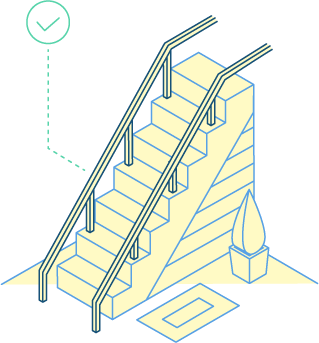According to the 2017 Disability Statistics annual report, the percentage of disabled people in the United States was 12.8% and has been steadily rising over the last five years. Advances in the understanding of disabilities, as well as adaptive technology, means that more and more disabled people are able to redesign their homes to mitigate the impact of their disability.
However, there remain legitimate ways in which homes can still be unsafe for those with disabilities.
By going through this guide, you can create a ‘checklist’ of items to be aware of, allowing you to address any potential safety issues in your home.

When it comes to making your home safe for those with disabilities, one of the most important steps is making sure that they can move freely and easily around the home. One of the most dangerous aspects of living in a non-adapted home is the need to access things out of reach or having to maneuver in an uncomfortable or unnatural way.
The most dangerous areas for disabled people in this respect are the kitchen and the bathroom, where the presence of cooking and bathing equipment, combined with reduced mobility, means that there is always the chance of additional danger.
Furthermore, for those who have impaired vision or hearing, there are added requirements when it comes to safety. Finally, the biggest danger for disabled people is the same as that for non-disabled people: fire. Being prepared for fire is essential to maximizing the changes of disabled people remaining safe.
KITCHENS
Kitchens are potentially the most dangerous room in any home, with a variety of sharp objects, open flames, and boiling water around to cause damage. They are also some of the most regularly used rooms in the house.
For individuals with disabilities, making a kitchen accessible is the most important first step.
Being able to move around without impediment and having free access to all of the storage space and cooking equipment may involve some modifications.
SOME SAFETY MODIFICATIONS – as recommended by the Amputee Coalition of America (ACA) – are as follows (all advice is based upon an individual using a wheelchair):

Lowering a stovetop to 28 inches above the ground will allow you to see what is inside the pots. You could also look to install a ‘pot-filler’ to avoid the need to carry water from sink to stove.
Ovens should have controls on the front rather than on the top so that they can safely and quickly be shut off without having to reach across burners.
Mirrors installed on the ceiling (for example above the oven, or above the stove top) will allow you to see what is inside as it cooks.
For those with mobility issues in the upper limbs, ceramic cooktops allow pots and pans to be slid, rather than carried.
Before undertaking any modifications to the layout of your kitchen and your surfaces, you should measure your range of motion.
If you use a wheelchair, for example, you should measure all the dimensions of the chair, including foot and armrests. This will allow you to determine how high your counters should be. Moreover, think about how high your oven, refrigerator, and dishwasher should be. Using these conveniently is the first step to using them safely.
Regardless of your level of disability, you should have at least one fire extinguisher in your kitchen. You should make sure you know how and are able to use it, as well as where it is kept.
If you have mobility issues, then having more than one fire extinguisher is a must (for more information on fire extinguishers, see the section on Fire Safety, below).
BATHROOMS
Bathrooms are potentially one of the trickiest rooms for people with disabilities due to the difficulty of maneuvering onto and off the toilet, in and out of the bath/shower, and the added complexity of doing so when floors are potentially wet.
The addition of water makes everything more difficult and, as a result, more dangerous.
For those who use a wheelchair, all doors need to be more than 32 inches wide to allow the wheelchair to pass through. This is true of doors throughout the home but may also apply to shower doors in the case of a roll-in shower.
The ACA recommends the following when it comes to increasing the safety of those moving from a wheelchair to a bathtub/shower or to the toilet. Again, each of these is contingent upon the type and scope of the disability that the individual has. Another option is having a walk in tub installed. This can be very expensive though and ranges around $3,000 to $10,000.
AS WITH THE KITCHEN, IT IS NECESSARY TO TAKE STOCK OF THE RANGE OF MOTION AND PARTICULAR LIMITATIONS BEFORE CONSIDERING THE FOLLOWING:1. Grab bars2. Seats that are specially designed for transferring onto/off of3. Mats for inside the bathtub (or shower, if applicable) that are non-slip4. A bench that extends outside of the bathtub5. A shower seat that can swivel around6. A shower that you can roll a wheelchair into
A key tip from the ACA is that many bathroom modifications may leave pipes exposed (for example, in the case of lowering a sink).
Exposed pipes may present an additional risk of burns, and therefore need to be covered and insulated.
For those who are cohabiting with someone with a disability, the following modifications are recommended. Again, these are all designed to make using the bathroom easier, and thereby make it safer.
CONSIDER THE FOLLOWING:1. Adjustable sinks, toilets, and shelves, each of which can be altered in terms of its height. This allows for disabled and non-disabled users to share a bathroom without additional inconvenience.2. Toilet flush extensions and clamps for toilet paper – this is designed for those who have mobility issues in their upper limbs, and therefore struggle with grip.3. Temperature controls for water. Increasingly this is being mandated in many cities and states for new bathrooms; however, installing these will help prevent burns, particularly in those who have little feeling in their extremities, and therefore may not initially realize that the water is dangerously hot.
STAIRWAYS AND RAMPS
Getting in and out of the home safely is something that many non-disabled individuals take for granted. However, the dangers of steps and stairs are extreme for those with disabilities.
Difficulties with mobility, balance, and upper or lower body strength all conspire to make stairs a potential hazard.
THERE ARE A NUMBER OF THINGS YOU CAN DO TO MAKE STAIRWAYS, STEPS, AND RAMPS FAR SAFER FOR THOSE WITH DISABILITIES:

- Install handrails. In some jurisdictions these are mandatory. However, you should also confirm that your handrails are up to scratch, making sure they meet the following criteria:
- They should support at least 250lbs in weight.
- They should be attached to studs or blocking (i.e. not sheetrock).
- They should be placed 1.5 inches from the walls (on both sides of the staircase).
- They should go beyond the staircase at both the top and bottom to allow people support when exiting and entering the stairway.
Staircases should also be well lit, meaning that the lighting should not allow for glare or shadows. In either case, those with vision problems may misjudge where the stairs are because of poor lighting. Generally, downward-facing lights under the handrail are optimal.
- Staircases should be free of all items at all times, as this may present a tripping hazard. This is especially true on basement stairs, as they tend to be steep and narrow. You may want to consider remodeling the basement to remedy this.
- Staircases should be well maintained to avoid disintegration and unevenness. For example, there should not be loose stones, bricks, or planks, and outdoor steps should be kept free of ice.
- The riser height should follow local building codes and be no less than 7 inches. The treads should also be large enough that individuals’ feet extend beyond the edge, which is a major tripping hazard.
- Any ramps should have a gradient less than 1:12 to make it easier for those using wheelchairs and walkers to use them. Ramps should follow all of the upkeep and tidiness rules of stairs. Ramps should also be made of a non-slip surface (which can be achieved with non-slip paint or adhesive strips).
As a general rule, if you are unsure about any of the above, have the work completed by a professional. This will allow you to ensure that it is completed correctly, and therefore is as safe as possible. If you are no longer able to go up and down stairs, you should consider adding a stair chair lift to your home.
FIRE SAFETY
According to the National Fire Protection Agency (NPFA), the majority of fire deaths occur in the home.
The danger of fire is compounded for those with disabilities, as they may be less likely to stop a fire from spreading, less likely to hear a traditional smoke alarm, and may be less able to safely exit the building. In all of the above cases, advanced preparation is critical to minimizing risk.
THE NPFA RECOMMENDS THE FOLLOWING:
Installing home fire sprinklers. These sprinklers may not always be able to extinguish a fire, although they work to keep fires small, thus increasing the time available to safely leave the building.

The rule for smoke alarms is that they should be:
- In every sleeping room
- Outside every sleeping area
- On every level of the home
You should also test your smoke alarm every month to check that it still works.
Ideally, you smoke alarms should be interconnected so as to give more warning (this is particularly true for those who have trouble hearing).
For those who are deaf, you can buy and install one (or more) of the following alarms:
- Strobe light alarms, which flash when the alarm sounds
- Pillow or bed alarms, which vibrate when the alarm goes off
- For those who are hard of hearing, a low-pitched sound alert device may be a good option, in conjunction with one of the other items.
In addition to the hardware available, you can also make your home safer through planning and preparing. Making a plan for escape, particularly if you live with other people, will help you to think about what to do. Running a fire drill will make sure you know your role in the event of a fire.
If you do have a plan, you can speak to your local fire department and ask them to review your plan. They may have a directory of people who require additional help that you can be added too. This will alert them in case of a fire, and they will be aware of your specific needs.
You should also install a phone by the side of the bed in case you need to call for help in case of a fire or an emergency.
The numbers of disabled people in the United States is constantly increasing. Indeed, in West Virginia, an estimated 20% of the population has some form of physical disability, the highest in the U.S. (by comparison, Utah has only 9.9% of its population estimated to be disabled).
The relative growth of disabled citizens, as well as improvements in technology, have made modifications easier, cheaper, and better than at any time in history. Individuals with disabilities are now able to customize their home to fit their specific needs.

Despite this, disabled people have additional needs when it comes to safety. Often things which are relatively safe for non-disabled individuals are not safe for the disabled. This means that homes for disabled people require additional equipment to help them minimize risk from everyday activities.
Along with things like falls or slips, issues such as cooking and bathing take on additional hazards.
Furthermore, fires are especially risky for those with disabilities due to the limited mobility, or – in the case of those with vision or hearing loss – the difficulty of responding the same external stimuli as a non-disabled person.
Generally, technology can provide a great deal of assistance for a disabled person. However, there remains a need for additional planning and preparedness to mitigate risk and to make a home as safe as possible for a disabled person.
